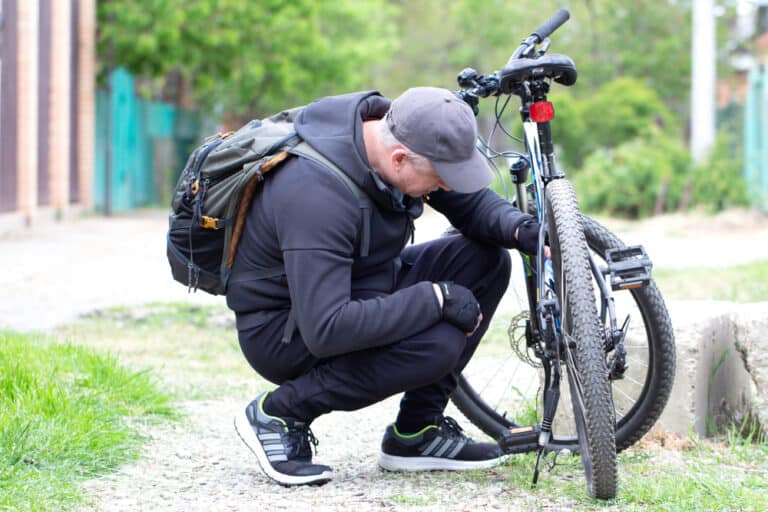Can You Ride A Bike With a Rusty Chain?

If we do not take good care of our bike chains, ultimately, we could face various problems. Your bike may have been sitting outside for a while, and if it is a wet climate or you live near the ocean, you are more likely to find the chain may have rusted. Rust on a chain is not a good sign. Additional friction will come into play, and it could cause damage to the bike, but can you still ride it?
Typically speaking, it is possible to ride a bike with a low to moderate amount of rust on it (this should sit below 50%, but even better, 30%); in this state, it is less likely to cause damage to your drivetrain. It must be noted that rust ultimately weakens a bike chain and could damage it.
People who enjoy riding their bikes may find this to be a glorious past-time; however, the need to maintain the bike and all its elements is not exciting. It may be this, or perhaps the individual is unaware that bike chains require regular maintenance to function correctly. So your bike has a rusty chain; following this, we shall discuss the ins and outs of whether you can ride it.
Riding A Bike With A Rusty Chain
It is possible to ride a bike with a rusty chain; however, you first need to establish how badly the chain has rusted. That is because riding with a rusty chain can be unsafe, and it is often hard to predict whether it will get you through your ride, break, or outright snap during the ride. Therefore, cleaning and degreasing the bike before riding would be best if you have the time.
If you have enough time, then it would also be highly advisable to remove as much of the rust as possible before you take the bike for a ride. If your bike chain has been rusting for a prolonged period and is covered in more than 50% rust, the likelihood of it breaking increases drastically, and we would advise replacing the chain before riding.
The reason for this is that the rusted chain will make the derailer and cogs stiff, and resultantly, getting them to move while you pedal will be taxing. Also, if you ride with a rusted chain, the likelihood of you needing to work harder to crank the pedals will undoubtedly increase. Additionally, the bike will perform relatively poorly, which could mean you are slowed down by up to 30%.
Going further, if the chain is too severely rusted, it could ultimately cause irreversible damage to your bike. It will most certainly affect the shifting of gears, leading to the drivetrain being damaged. Apart from the performance and damage a rusty chain can cause, if it were to snap, it could even cause you harm while riding if it happens to snap and you lose control of the bike.
It may ultimately snap because the rust on the chain definitely impacts the chain’s integrity, meaning that it will struggle to withstand the tension placed upon it as you pedal. If the chain is badly rusted, the chances of it snapping change from if it will to when it will.
On the other hand, you may assess and clean the bike chain, remove the rust, and find that the metal is still strong enough and not too severely damaged. In this case, the bike chain should be safe to use; if you continue to care for it properly, it could end up lasting you for years to come.
How Quickly Can A Bike Chain Rust?
Depending on where you store your bike, the local climate, and the sort of maintenance you either do or do not do on your bike, specifically the chain, signs of rust can appear in as little as 4-5 days. This is far more likely to happen if your bike is kept outdoors. However, if you clean and lubricate the chain regularly, this should prevent the formation of rust.
Additionally, it is far more advisable to store your bike indoors, whether in your house, apartment or even the garage, as this is an easy and practical step to ensure against the formation of rust on the chain.
When we look at bike chains, many are made from alloy steel or plain carbon; however, some are also nickel-plated, which is done to prevent rust. Thus, most modern bike chains are less prone to rust, especially if they have been coated. With this being said, most chains are formed from thin metal and quickly become weakened if rust starts to form.
If you see that your bike chain is severely rusted, even if it has only stood outside in the elements for a short period, it may be wise to consider replacing it outright, as it will affect the overall health of your bike.

Caring For Your Bike Chain
Although it may be tiresome, caring for your chain is a crucial part of owning a bike. If a chain is dirt and rust riddled, you will have to work harder to pedal, and the chain is likely to cause damage to other components. Your bike chain may well be exposed to grime and the elements; therefore, it can happen rather suddenly that a good chain goes bad.
One of the critical components of chain maintenance is ensuring that it is always well lubricated with the correct type of oil. However, if the chain is dirty and rusted, simply adding lubrication will not solve the problem. All that will achieve is the creation of an abrasive paste that is not what we want.
However, with that being said, you will not need to clean the chain thoroughly before each time that you apply the oil. It needs to be cleaned if it is dirty and rusty, and you cannot read the brand or model name stamped on the chain. You will need to assess the chain and decide; if you are unsure, search online and see what state your chain should be in and what looks like a problematic situation.
Conclusion
You will need to judge whether the bike is rideable by assessing the chain’s condition. If it is covered in less than 30-50% rust, it should be alright to get on and ride. However, keeping the chain in good condition does not take much effort by cleaning it, scrubbing off the rust, and ensuring it is well lubricated. Doing this will extend the chain’s lifespan and avoid needing to replace it.
References
- https://www.cyclescheme.co.uk/community/how-to/chain-care
- https://conditionandnutrition.com/can-you-ride-a-bike-with-a-rusty-chain-chain-maintenance/
- https://www.femmecyclist.com/rusty-bike-chain/
- https://www.wikihow.com/Remove-Rust-from-a-Bike-Chain
- https://mountainbiketrailsnearme.com/bike-maintenance/can-you-ride-a-bike-with-a-rusty-chain/







